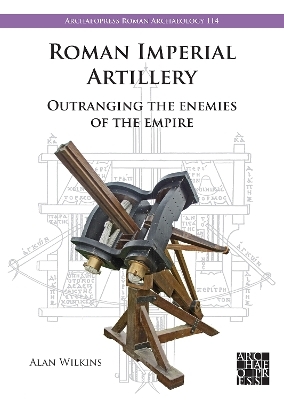
Roman Imperial Artillery
Archaeopress Archaeology (Verlag)
978-1-80327-783-7 (ISBN)
Greek and Roman torsion catapults were the most powerful missile projectors in the western world from their invention in the 4th century BC to the 11th century AD. Powered by the energy stored in tensioned and twisted rope springs, they outranged archers, slingers and all other missile launchers. After tracing their Greek origins, Roman Imperial Artillery describes the machines used from the time of Sulla and Caesar, the Roman improvements in their design and power, and their importance in the defence of the Roman Empire. Full-size reconstructions, made in collaboration with engineers Len Morgan and Tom Feeley, are based firmly on the author’s revised editions of the texts of the Greek and Roman engineers, the latest archaeological finds and the evidence of relief sculptures. This revised edition analyses remarkable new finds from the Rhine frontier in the Netherlands and elsewhere. The 1999 find of a catapult frame in Germany allows an accurate reconstruction of the standard early Imperial bolt-shooter, as used in the AD 43 invasion of Britain by Vespasian against hillforts at Maiden Castle and Hod Hill. The siege-camps at Burnswark Hill, Dumfriesshire are investigated. Range and accuracy are examined, and technical tests demonstrate the strike power of these formidable and long-lived weapons.
Alan Wilkins studied Classics at Lancaster Royal Grammar School and read the subject at Emmanuel College, Cambridge, specialising in ancient history and archaeology under Professors Jocelyn Toynbee and A. G. Woodhead. He spent several years excavating on Roman military and civilian sites in Britain, and was a field assistant to Sir Ian Richmond for 17 years. He lectured on Greek and Roman Civilisation for Liverpool University’s Extra-Mural Department, and was one of the pioneers of the JACT evidence-based teaching of Greek and Roman history. After 30 years teaching Classics at Woodbridge School, Merchant Taylors School, Crosby and Annan Academy, he turned to the subject of Greek and Roman artillery, following the tragic early death of his friend Dr Eric Marsden. He has attempted to maintain the momentum of Eric’s research into the subject. He is a Fellow of the Society of Antiquaries of London.
Acknowledgements
Preface
Glossary
Weights and measures
Introduction
Greek origins
The menace of the new weapon
The bolt-shooter: accuracy, range and effects
Reconstructing the Roman bolt-shooter
The new design: the metal frame arch strut cheiroballistra/manuballista
Deciphering the manuscripts: Vitruvius’ ballista
The stone missiles: range and effects
Masada AD 73-74
Qasr Ibrim: artillery in defence. Inscribed stone shot
Artillery in action in the field: Arrian’s battle plan
Burnswark Roman camps and native hillfort, Dumfriesshire
The last stone-throwers
The Hatra stone-thrower and the inward-swinging arms theory
Survival
The Roman achievement
Future search and research
The Roman origin of the mediaeval revolving-nut crossbow release
Review of 2021 TV film on Burnswark Hill, ‘Massacre on Hadrian’s Wall’
Sources and references to artillery
| Erscheinungsdatum | 30.05.2024 |
|---|---|
| Reihe/Serie | Archaeopress Roman Archaeology |
| Zusatzinfo | 161 figures (colour throughout) |
| Verlagsort | Oxford |
| Sprache | englisch |
| Maße | 174 x 245 mm |
| Themenwelt | Geisteswissenschaften ► Archäologie |
| Geschichte ► Allgemeine Geschichte ► Vor- und Frühgeschichte | |
| Geschichte ► Allgemeine Geschichte ► Altertum / Antike | |
| Geschichte ► Teilgebiete der Geschichte ► Militärgeschichte | |
| ISBN-10 | 1-80327-783-1 / 1803277831 |
| ISBN-13 | 978-1-80327-783-7 / 9781803277837 |
| Zustand | Neuware |
| Haben Sie eine Frage zum Produkt? |
aus dem Bereich


